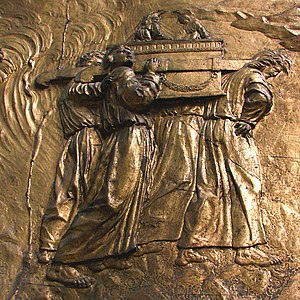 Image via WikipediaEach sacred tradition has some way of connecting what we consider to
be the objective, or external world, to the subjective, or internal
world. Even those which state that it is all one in God or in Mind or
the like.
Image via WikipediaEach sacred tradition has some way of connecting what we consider to
be the objective, or external world, to the subjective, or internal
world. Even those which state that it is all one in God or in Mind or
the like.In Nichiren Buddhism, this is the Gohonzon, a scroll with sacred writing embodying the Lotus Sutra. One is to chant to the scroll, which is a physical representation of the Buddha-nature in the person chanting. The outer representation of the altar and scroll, recalling the Ceremony in the Air, is supposed to merge with the inner landscape of those performing this ritual.
In Shin Buddhism and in the larger realm of Pure Land Buddhism, the same can kind of association can be applied to its ceremonies and to the imagery of Amitabha Buddha and the Pure Land.
In Judaism, this externality was the Ark of the Covenant carrying the tablets of Moses as well as the tent in which it (and the Spirit of God) resided. It was also associated with the Temple in Jerusalem, and after the last demolition of the temple building, it was associated with the scrolls of the Torah itself. In Christianity, after and perhaps prior to the destruction of the Temple in Jerusalem, this externality was transferred to the person of Jesus of Nazareth and was then extended to the Eucharist. And so on.
And I can hear some mumbling. "So what?"
The thing is, this seems to be important. I won't go into examples for Islam, Zen, etc, but they can be found as well. So why is it that having this convergence of "outer" and "inner" landscapes matters? That's hard to say, as any answer presumes quite a bit about human experience. Yet it does seem to be a matter of emphasis that the external landscape of the religious ceremony reflect both the desired and the actual state of the inner landscape.
One can speculate that by reflecting the desired inner state the ceremony sets up a framework and an expectation which can become the foundation for change. Or that by reflecting the actual, deeper inner state, it is like a reminder that resonates with something we already find true but cannot otherwise articulate. Or perhaps it is both simultaneously.
Still, while there is sometimes tension between formal religion and personal spirituality, they can and do meet in this ceremonial space. And it is in this meeting that the saints and holy people of each sacred tradition emerge. Even those who may seem to be beyond institutional limitations.
This is where a beginner's cautious faith or trust does or trust either does or does not permit a sufficient suspension of disbelief, the opening to a new way of looking at herself and the world. This may seem easy for some, especially at the a more superficial level of understanding, but at a deeper level of introspection and with a cultural emphasis on reducing everything to that which appears obvious and rational, a gateway to embracing ambiguity and mystery that is expansive and cannot be framed in terms of logical clarity and certainty becomes even harder to enter.
In his book The Shattered Lantern Ron Rolheiser has described a need for an informed or mature naivety which allows us to get past this kind of hurdle, but it is still too much for many people to attempt. Do you have experience with facing this kind of challenge? If so, please share your insights into the matter.


I like this. I think this is very worthwhile.
ReplyDelete